
The Main Street Historic District encompasses the historic commercial center of Middletown, Connecticut, United States. Middletown was one of the most important ports on the Connecticut River during the colonial period, and Main Street "has been the center of community life since the earliest period of settlement". Today Main Street is home to a number of 19th century buildings, maintaining the bulk of its historic character. It was listed on the National Register of Historic Places in 1983.
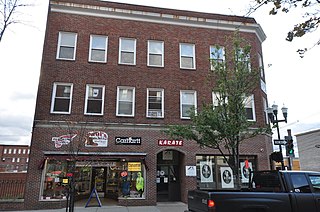
The Lower Lisbon Street Historic District encompasses part of the earliest commercial center of Lewiston, Maine. Located on the west side of Lisbon Street, the city's main commercial area, between Cedar and Chestnut Streets are a collection of commercial buildings representing a cross section of architectural styles, built between 1850 and 1950. When the historic district was listed on the National Register of Historic Places in 1985, it included 18 buildings. Eleven of these have since been demolished, and one has a significantly altered facade.

The Saco Historic District encompasses the historic commercial and residential centers of Saco, Maine. Covering more than 100 acres (40 ha) of central Saco, it includes houses from the 18th through 20th centuries, and the main business district along Main Street. It was added to the National Register of Historic Places in 1998.

The Manlius Village Historic District is a 15-acre (6.1 ha) historic district on the east side of the village of Manlius, in the town of Manlius, New York, about 9.5 miles from the downtown of Syracuse.
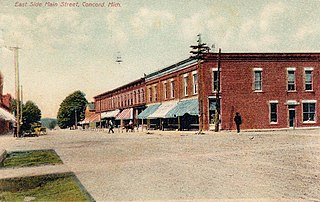
The Concord Village Historic District in Concord, Michigan dates back to 1836, and consists of historic structures located along Hanover Street from Spring to Michigan Streets and North Main Street from Railroad to Monroe Streets. It was listed on the National Register of Historic Places in 1996.

The Downtown Gloversville Historic District is a national historic district located in Gloversville, Fulton County, New York. It is roughly bounded by Spring, Prospect, West and East Fulton, North and South Main, and Elm Streets.
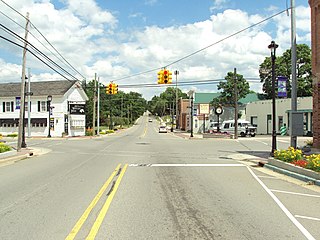
The Metamora Crossroads Historic District is a historic district centered at the intersection of Oak and High Street in the small village of Metamora in Metamora Township in Lapeer County, Michigan. It was designated as a Michigan State Historic Site and also added to the National Register of Historic Places on July 19, 1984.

The Delphi Courthouse Square Historic District in Delphi, Indiana is a 23-acre (9.3 ha) area roughly bounded by Monroe, Main, Market and Indiana Streets. It was listed on the National Register of Historic Places in 2010. It includes Italianate architecture and Classical Revival architecture and work by Elmer Dunlap among its 31 contributing buildings.

The Broad Street Historic District encompasses a significant portion of the historic center of Bethel, Maine. Broad Street dates to the early days of Bethel's settlement in the early 19th century, and its town common was a gift from the first settler of the area. As originally listed on the National Register of Historic Places in 1977, the district included the common and a section of Broad Street between Main Street and Paradise Hill Road. This was expanded in 1990 along Church Street to encompass historic homes and a portion of the Gould Academy campus.
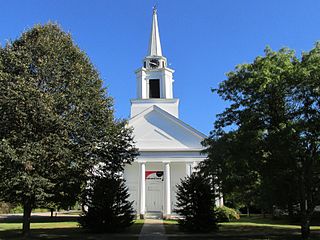
The Main Street Historic District of Fryeburg, Maine, encompasses the growth of the town's principal village between about 1800 and 1935. It extends along Main Street, from Woodland Street in the north to Portland Street (SR 5 and Maine State Route 113) in the south, and includes forty primary buildings on 55 acres (22 ha). The district was listed on the National Register of Historic Places in 1991.

The Norway Historic District encompasses most of the historic village center of Norway, Maine, and is reflective of the town's growth over 150 years. Although significant early-to-mid 19th century buildings survive in the village, it was significantly damaged by a major fire in 1894, resulting in the construction of a number of new brick and wood frame buildings. The district, which is 44 acres (18 ha) in size, includes 64 historically significant residential, civic, social, and commercial buildings, and was listed on the National Register of Historic Places in 1988.
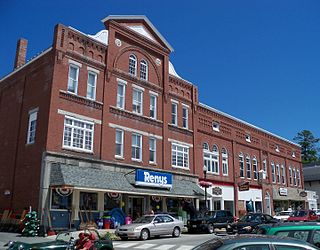
The Farmington Historic District encompasses much of the main central business district of Farmington, Maine. Farmington was settled in the 1770s, and experienced its most rapid growth after being named the shire town of Franklin County in 1838, with a secondary spurt of redevelopment after a major fire in the 1880s. Its central business district encompasses many of the town's historic resources, and its most significant commercial and civic architecture. The district, which includes more than 130 resource over 85 acres (34 ha), was listed on the National Register of Historic Places in 1995.
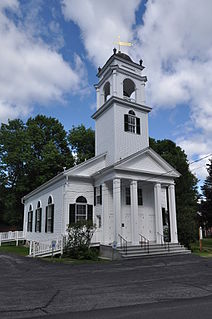
The Waterford Historic District encompasses the well-preserved historic town center, also known as Waterford Flat, of the rural inland town of Waterford, Maine. Settled in 1775, the town grew around a site where Kedar Brook empties into Keoka Lake. The oldest surviving building, the Lake House, dates to 1797, while most of the houses were built before 1850. Prominent public buildings include a series designed by John Calvin Stevens, including the Knight Library, Wilkins Community Hall, and First Congregational Church. The district was listed on the National Register of Historic Places in 1980.

The West Market Square Historic District encompasses one of Bangor, Maine's central urban business districts. Located at the junction of Main and Broad Streets, it has been a focal point of Bangor's economy and business since the city's incorporation in 1834. The district includes seven buildings reflective of its appearance in the late 19th and early 20th centuries; it was listed on the National Register of Historic Places in 1979.
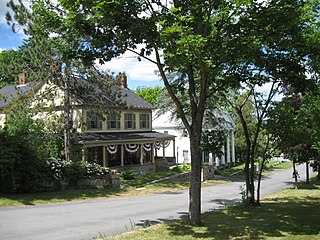
The Calais Residential Historic District encompasses the town's best collection of well-preserved 19th-century residences in Calais, Maine. Located on Calais Street and Main Street, the district includes twenty properties developed between the early 19th century and 1900. It was listed on the National Register of Historic Places in 1994.
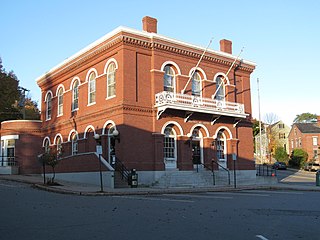
The Belfast Historic District encompasses a large portion of the city center of Belfast, Maine, representing one of Maine's largest concentrations of pre-Civil War architecture, as well as a rich collection of commercial architecture of the late 19th and early 20th centuries. The district was listed on the National Register of Historic Places in 1986, with minor enlargements in 1993 and 1995.
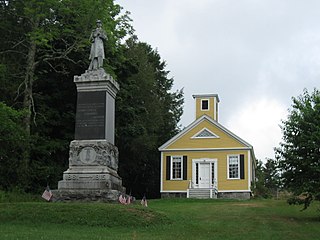
The Dennysville Historic District encompasses the historic town center of Dennysville, Maine. Located near the southern end of the large rural community, its architecture covers more than 100 years of community history, from the early 19th to early 20th centuries. The district extends along Main Street between Maine State Route 86 and Bunker Hill Road, on the west bank of the Dennys River. It was listed on the National Register of Historic Places in 1982.

The Searsport Historic District encompasses a collection of well-preserved mid-to-late 19th-century commercial buildings in the center of Searsport, Maine. They represent the community's peak period of prosperity, when it was a leading shipping and shipbuilding center. The district was listed on the National Register of Historic Places in 1979.

The Richmond Historic District encompasses the historic village center of Richmond, Maine. Established in the 17th century, the town reached its height of prosperity in the 19th century as a major shipbuilding center on the Kennebec River. The district was listed on the National Register of Historic Places in 1973.

The Constantine Historic Commercial District is a primarily commercial historic district located in Constantine, Michigan along Washington Street between Second and Water Streets, and along Water Street between White Pigeon Street and 125 West Water. It was listed on the National Register of Historic Places in 1985.






















